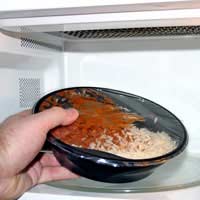Making The Most of Your Microwave

Most kitchens now have a microwave nestled in them somewhere and while they may not be one of the most attractive appliances, they're certainly one of the most useful. It's true that some people abhor them because of their associations with ready-meal culture but if they're used sensibly they really can be a great help.
What can you Cook?
You'd be surprised just how versatile the microwave is and there are plenty of occasions when it's quicker and simpler to use it instead of heating up the oven. As with all kitchen appliances, it's best to start off by preparing something very simple like a jacket potato. Obviously, re-heating is one of its main jobs but casseroles, vegetables, chicken and meat can all be cooked in the microwave, saving time and effort.It's a particularly useful gadget for a student kitchen as, inevitably, there's often going to be two or more people in the kitchen cooking different meals. When this happens, you don't necessarily need to wait for your turn at the oven: just pick something that can be cooked in the microwave. It will also come in handy if you're cooking for a crowd - use it to cook the vegetables for your roast dinner, if you run out of space on the hob.
A Healthy Option
Believe it or not, microwaving is actually a pretty healthy way to cook. Unlike other methods, such as frying, you don't really use any oil when you cook in the microwave so food will have a lower fat content. Vegetables tend to steam themselves and therefore retain more minerals than they do with other types of cooking. They also cook a lot more quickly than if you were boiling them so again, fewer nutrients will be lost. So, it is possible to use your microwave to create complete, healthy meals. It might also mean you're less likely to dial for a takeaway whenever cooking seems like too much hassle. A couple of spuds and a can of beans is all you need to create a filling, nutritious meal that takes less than ten minutes to prepare.Top Tips for Microwave Cooking
- Never put metal containers or implements in the microwave.
- Pierce film lids, or foods with skin, before cooking to stop them 'exploding'.
- If you're reheating a meal or soup, stir it halfway through cooking to ensure the food is cooked through evenly.
- Allow your food to stand for a minute or two before you eat it. Microwaves can be deceptively powerful and you might have a bit of a hot spot.
- Use your microwave to quickly and safely defrost food before cooking.
- Freeze meal leftovers in individual, microwavable containers so it's easy to just heat up one portion.


Re: Working Out a Food Budget
Great advice! Setting a food budget is all about balance, and these tips really help to keep things manageable without compromising on…
Re: How to Make Basic Sauces
nice, but i think it would be better if you had, like, satay sauce, and garlic dip. but still, nice.
Re: Organising Your Kitchen
how do l cook jollof rice and frid rice..also vegetable soup..
Re: Dinner in 10 Minutes
What else can you do with jacket potato I have butter and a bit of gravy with mine
Re: The Quick Guide to Great Cooking
i'm a student want to learn more basic sauce and any additional ingredients for cream sauce white sauce.thank you
Re: Ten Ideas for Jacket Potatoes
Please could you add pictures of the goods if possible.
Re: How to Cook Fish
Your advice on poaching (and other ways of cooking) haddock seems very sensible and in touch with real life. This ( I know comparisons are odious…
Re: Ten Ideas for Jacket Potatoes
Could you help me with easy toppings for jaket bbq bake potatos ,for to cook 30 at a time need some help ,so come all you great…
Re: Meals for £1
Bb - Your Question:Students don't have luxrys like oil and an onion just hanging about or pepperOur Re
Re: Cooking in Bulk
Go into supermarkets late in the day and pick up reduced veg, Take home cut up in dinner portion Bags up in freezer bags Put in freezer til you…